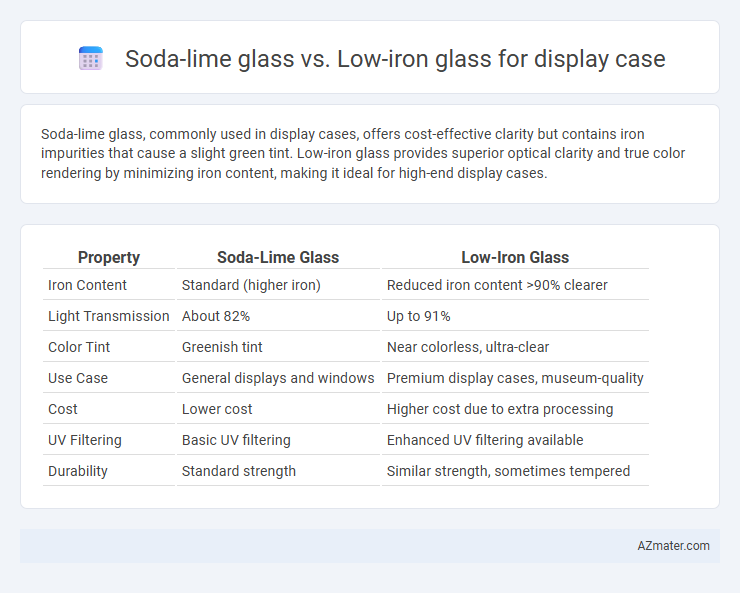Soda-lime glass, commonly used in display cases, offers cost-effective clarity but contains iron impurities that cause a slight green tint. Low-iron glass provides superior optical clarity and true color rendering by minimizing iron content, making it ideal for high-end display cases.
Table of Comparison
| Property | Soda-Lime Glass | Low-Iron Glass |
|---|---|---|
| Iron Content | Standard (higher iron) | Reduced iron content >90% clearer |
| Light Transmission | About 82% | Up to 91% |
| Color Tint | Greenish tint | Near colorless, ultra-clear |
| Use Case | General displays and windows | Premium display cases, museum-quality |
| Cost | Lower cost | Higher cost due to extra processing |
| UV Filtering | Basic UV filtering | Enhanced UV filtering available |
| Durability | Standard strength | Similar strength, sometimes tempered |
Introduction to Soda-lime Glass and Low-iron Glass
Soda-lime glass, the most common type of glass, consists primarily of silica, soda, and lime, offering cost-effective durability and moderate clarity for display cases. Low-iron glass contains significantly reduced iron content, resulting in higher transparency and superior light transmission, enhancing the visibility of items within display cases. Choosing between soda-lime and low-iron glass impacts both aesthetic appeal and functional performance in showcasing exhibits.
Chemical Composition Differences
Soda-lime glass primarily comprises silica (SiO2), soda (Na2O), and lime (CaO), offering standard clarity and cost-efficiency for display cases. Low-iron glass reduces iron oxide (Fe2O3) content significantly, resulting in higher visible light transmission and superior optical clarity by minimizing the greenish tint common in soda-lime variants. These chemical composition differences influence the choice between soda-lime and low-iron glass based on the desired transparency and color neutrality in display case applications.
Optical Clarity and Light Transmission
Low-iron glass offers superior optical clarity and higher light transmission rates, typically around 91%, compared to standard soda-lime glass, which transmits roughly 83-85%. This enhanced transparency allows for more vivid and true-to-color display case presentations, minimizing greenish tint distortions common in soda-lime glass. Using low-iron glass in display cases maximizes visibility and color accuracy, making it the preferred choice for showcasing valuable or color-sensitive items.
Color and Visual Appearance
Soda-lime glass typically exhibits a slight green tint due to its iron content, which can affect the color accuracy and visual clarity of items displayed inside a case. Low-iron glass offers superior transparency with minimal greenish hue, delivering a clearer, more true-to-color presentation ideal for high-end displays. The enhanced light transmission of low-iron glass significantly improves the vibrancy and detail visibility of displayed objects compared to standard soda-lime glass.
Strength and Durability Comparison
Soda-lime glass, commonly used in display cases, offers good strength and reasonable durability but can be prone to minor scratches and is less resistant to impact compared to low-iron glass. Low-iron glass provides enhanced strength, higher clarity, and superior durability due to its reduced iron content, making it more resistant to chipping and cracking under stress. For display cases requiring both robustness and long-lasting clarity, low-iron glass is the preferred option given its improved mechanical properties and resistance to environmental wear.
Cost Implications for Display Cases
Soda-lime glass is a cost-effective option for display cases, offering affordability and adequate durability for most standard applications. Low-iron glass, while more expensive, provides superior clarity and color accuracy, making it ideal for high-end displays where visual impact is critical. The higher initial investment in low-iron glass can be justified by the enhanced aesthetic appeal and reduced color distortion in premium exhibition environments.
Suitability for Artifacts and Valuable Displays
Soda-lime glass, commonly used in display cases, offers adequate clarity and protection but may slightly distort colors due to its greenish tint, making it less ideal for high-value artifacts requiring true color representation. Low-iron glass, with its enhanced transparency and minimal color distortion, is better suited for valuable displays, ensuring artifacts are showcased with accurate visual fidelity. Its higher UV resistance and reduced iron content provide superior protection against light damage, preserving delicate materials over time.
Maintenance and Cleaning Requirements
Soda-lime glass for display cases requires regular cleaning with non-abrasive, pH-neutral solutions to prevent surface scratches and maintain clarity, though it is more prone to mineral deposits and smudges compared to low-iron glass. Low-iron glass has enhanced durability and stain resistance, reducing the frequency of maintenance and making it easier to clean while preserving optimal transparency and color neutrality. Using microfiber cloths and avoiding harsh chemicals is essential for both glass types to extend their lifespan and maintain pristine display visibility.
Environmental and Sustainability Factors
Low-iron glass offers superior light transmission and clarity, enhancing display visibility while reducing the need for additional lighting and lowering energy consumption. Soda-lime glass, although more common and cost-effective, contains higher iron content resulting in a greenish tint that may require stronger artificial lighting, increasing energy use. Low-iron glass typically supports longer lifespan and recyclability, contributing to sustainability goals through reduced material waste and lower environmental impact during production.
Choosing the Right Glass for Your Display Case
Soda-lime glass is the most common and cost-effective option for display cases, offering good clarity and durability suitable for everyday use. Low-iron glass provides superior transparency and lacks the greenish tint found in soda-lime glass, making it ideal for high-end display cases where color accuracy and visual appeal are critical. Selecting low-iron glass enhances product visibility and creates an upscale look, but soda-lime glass remains practical for standard showcases due to its affordability and strength.

Infographic: Soda-lime glass vs Low-iron glass for Display case
 azmater.com
azmater.com